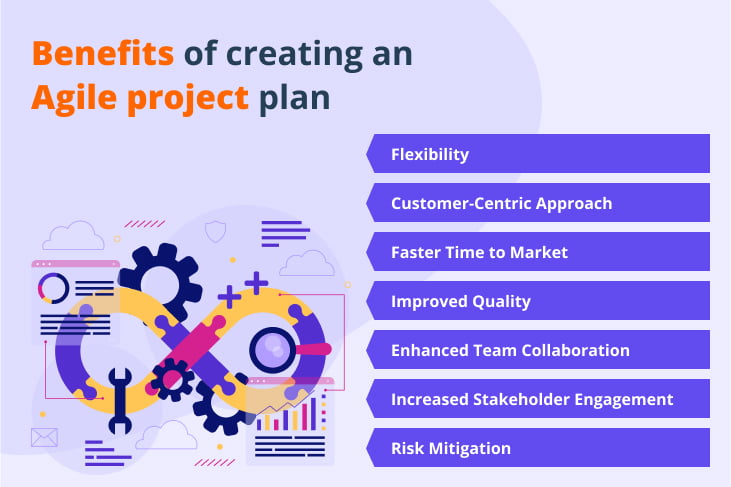In this post, we will walk you through the complexity of Agile project planning, providing you with the information and resources you need to construct a solid Agile project plan.
Benefits of creating an Agile project plan

- Flexibility: Agile development project plan is designed to be flexible Thus, it allows teams to adapt to changing requirements, priorities, and market conditions more effectively.
- Customer-Centric Approach: Furthermore, the Agile methodology project plan ensures that the project remains aligned with customer needs and expectations throughout the development process. Thus, it results in higher levels of customer satisfaction and product acceptance.
- Faster Time to Market: Moreover, Agile project planning promotes a faster time to market by breaking down the project into smaller iterations called sprints. Thus, teams can release products or updates to the market more frequently, gaining a competitive edge and capturing market opportunities sooner.
- Improved Quality: Agile project plan emphasizes the importance of continuous testing, inspection, and adaptation, which helps identify and address issues early in the development process.
- Enhanced Team Collaboration: Agile project management plan promotes cross-functional collaboration, transparency, and shared ownership among team members. By communication and collaboration, Agile teams can leverage the diverse skills and perspectives of team members to solve problems.
- Increased Stakeholder Engagement: The Agile methodology project plan encourages stakeholder involvement and feedback throughout the project lifecycle regularly. Thus, incorporating stakeholder feedback into the development process helps Agile teams to better align the project with stakeholder expectations.
- Risk Mitigation: Lastly, an Agile project plan promotes early and continuous risk identification, assessment, and mitigation through iterative development and frequent inspection.
Steps to create an agile development project plan?
Create a project vision
Start creating an Agile project management plan by defining the goal of the project. Mark down KPIs, USP, and create a story that the audience would like to hear.
Generally, the audience gets connected to the story of the product & they are encouraged to buy it. Ensure that the project vision is clear, simple, and in line with the organization’s strategic objectives and priorities.
Create a product log
Secondly, in Agile project planning make a prioritized list of features, functions, and tasks based on the requirements that have been collected.
Thus, when new information becomes available and priorities shift, the product log needs to be dynamic and ever-changing.
Define Iteration
Break down the tasks in the product log into smaller, more manageable tasks called sprints. Estimate the effort required to complete each task.
Define the duration and scope of each sprint, based on the team’s capacity and velocity. You can use Agile project planning software to create sprints, manage, and give time estimation to complete them.
Hold Sprint Planning Meeting
Every sprint should start with a sprint planning meeting to talk about the sprint goal, and decide which tasks will be accomplished.
Thus, work together with the development team to create the strategy for achieving the sprint objective, allocate tasks, and estimate work. Agile project planning software like Alian Hub is a useful tool for sprint planning, managing, and tracking.
Iterative Development
Concentrate on iterative development and testing throughout the sprint. To overcome any problems or obstacles that may come up, promote cooperation and communication both within members of the development team and with external parties.
Furthermore, organize daily scrums, or stand-up meetings, on a regular basis to discuss updates, progress, and problems.
Review
At the end of each sprint, hold a sprint review meeting to demonstrate the completed work to stakeholders and gather feedback.
Additionally, conduct a sprint retrospective meeting to reflect on the sprint process, identify areas for improvement, and implement changes to enhance team performance.
Release Planning
Because Agile release planning is a user-focused methodology that facilitates demand adaptation, it is widely utilized in software development.
You can keep the product development process moving forward and ensure that the work of your team is in accordance with what your target audience wants to see by putting it into practice.
Conclusion
In summary, the development of an Agile project plan is a prerequisite for the effective application of Agile techniques in project management. Furthermore, Agile project plan helps teams to react to change, offer value gradually, and achieve faster time-to-market.
It also maintains high levels of quality and stakeholder satisfaction. You can do this by embracing flexibility, customer-centricity, and iterative development.
Agile project planning enables teams to successfully manage the complexity of today’s changing business environment. Moreover, it helps to achieve project success via efficient communication, ongoing improvement, and a focus on providing customer value.

